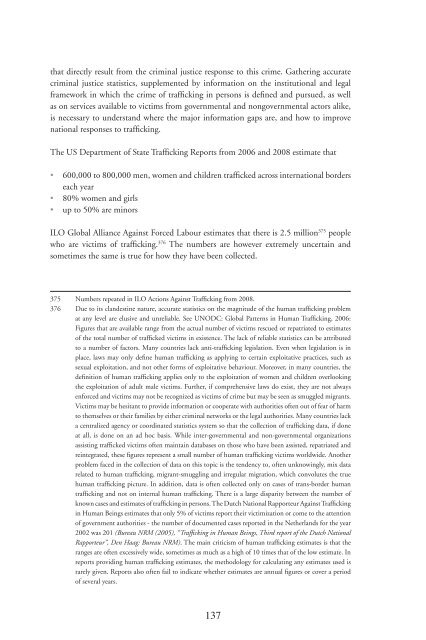Trafficking in human beings: human rights and ... - unesdoc - Unesco
Trafficking in human beings: human rights and ... - unesdoc - Unesco
Trafficking in human beings: human rights and ... - unesdoc - Unesco
Create successful ePaper yourself
Turn your PDF publications into a flip-book with our unique Google optimized e-Paper software.
that directly result from the crim<strong>in</strong>al justice response to this crime. Gather<strong>in</strong>g accurate<br />
crim<strong>in</strong>al justice statistics, supplemented by <strong>in</strong>formation on the <strong>in</strong>stitutional <strong>and</strong> legal<br />
framework <strong>in</strong> which the crime of traffi ck<strong>in</strong>g <strong>in</strong> persons is defi ned <strong>and</strong> pursued, as well<br />
as on services available to victims from governmental <strong>and</strong> nongovernmental actors alike,<br />
is necessary to underst<strong>and</strong> where the major <strong>in</strong>formation gaps are, <strong>and</strong> how to improve<br />
national responses to traffi ck<strong>in</strong>g.<br />
The US Department of State Traffi ck<strong>in</strong>g Reports from 2006 <strong>and</strong> 2008 estimate that<br />
600,000 to 800,000 men, women <strong>and</strong> children traffi cked across <strong>in</strong>ternational borders<br />
each year<br />
80% women <strong>and</strong> girls<br />
up to 50% are m<strong>in</strong>ors<br />
ILO Global Alliance Aga<strong>in</strong>st Forced Labour estimates that there is 2.5 million 375 people<br />
who are victims of traffi ck<strong>in</strong>g. 376 The numbers are however extremely uncerta<strong>in</strong> <strong>and</strong><br />
sometimes the same is true for how they have been collected.<br />
375 Numbers repeated <strong>in</strong> ILO Actions Aga<strong>in</strong>st Traffi ck<strong>in</strong>g from 2008.<br />
376 Due to its cl<strong>and</strong>est<strong>in</strong>e nature, accurate statistics on the magnitude of the <strong>human</strong> traffi ck<strong>in</strong>g problem<br />
at any level are elusive <strong>and</strong> unreliable. See UNODC: Global Patterns <strong>in</strong> Human Traffi ck<strong>in</strong>g, 2006:<br />
Figures that are available range from the actual number of victims rescued or repatriated to estimates<br />
of the total number of traffi cked victims <strong>in</strong> existence. The lack of reliable statistics can be attributed<br />
to a number of factors. Many countries lack anti-traffi ck<strong>in</strong>g legislation. Even when legislation is <strong>in</strong><br />
place, laws may only defi ne <strong>human</strong> traffi ck<strong>in</strong>g as apply<strong>in</strong>g to certa<strong>in</strong> exploitative practices, such as<br />
sexual exploitation, <strong>and</strong> not other forms of exploitative behaviour. Moreover, <strong>in</strong> many countries, the<br />
defi nition of <strong>human</strong> traffi ck<strong>in</strong>g applies only to the exploitation of women <strong>and</strong> children overlook<strong>in</strong>g<br />
the exploitation of adult male victims. Further, if comprehensive laws do exist, they are not always<br />
enforced <strong>and</strong> victims may not be recognized as victims of crime but may be seen as smuggled migrants.<br />
Victims may be hesitant to provide <strong>in</strong>formation or cooperate with authorities often out of fear of harm<br />
to themselves or their families by either crim<strong>in</strong>al networks or the legal authorities. Many countries lack<br />
a centralized agency or coord<strong>in</strong>ated statistics system so that the collection of traffi ck<strong>in</strong>g data, if done<br />
at all, is done on an ad hoc basis. While <strong>in</strong>ter-governmental <strong>and</strong> non-governmental organizations<br />
assist<strong>in</strong>g traffi cked victims often ma<strong>in</strong>ta<strong>in</strong> databases on those who have been assisted, repatriated <strong>and</strong><br />
re<strong>in</strong>tegrated, these fi gures represent a small number of <strong>human</strong> traffi ck<strong>in</strong>g victims worldwide. Another<br />
problem faced <strong>in</strong> the collection of data on this topic is the tendency to, often unknow<strong>in</strong>gly, mix data<br />
related to <strong>human</strong> traffi ck<strong>in</strong>g, migrant-smuggl<strong>in</strong>g <strong>and</strong> irregular migration, which convolutes the true<br />
<strong>human</strong> traffi ck<strong>in</strong>g picture. In addition, data is often collected only on cases of trans-border <strong>human</strong><br />
traffi ck<strong>in</strong>g <strong>and</strong> not on <strong>in</strong>ternal <strong>human</strong> traffi ck<strong>in</strong>g. There is a large disparity between the number of<br />
known cases <strong>and</strong> estimates of traffi ck<strong>in</strong>g <strong>in</strong> persons. The Dutch National Rapporteur Aga<strong>in</strong>st Traffi ck<strong>in</strong>g<br />
<strong>in</strong> Human Be<strong>in</strong>gs estimates that only 5% of victims report their victimization or come to the attention<br />
of government authorities - the number of documented cases reported <strong>in</strong> the Netherl<strong>and</strong>s for the year<br />
2002 was 201 (Bureau NRM (2005), “Traffi ck<strong>in</strong>g <strong>in</strong> Human Be<strong>in</strong>gs, Third report of the Dutch National<br />
Rapporteur”, Den Haag: Bureau NRM). The ma<strong>in</strong> criticism of <strong>human</strong> traffi ck<strong>in</strong>g estimates is that the<br />
ranges are often excessively wide, sometimes as much as a high of 10 times that of the low estimate. In<br />
reports provid<strong>in</strong>g <strong>human</strong> traffi ck<strong>in</strong>g estimates, the methodology for calculat<strong>in</strong>g any estimates used is<br />
rarely given. Reports also often fail to <strong>in</strong>dicate whether estimates are annual fi gures or cover a period<br />
of several years.<br />
137

















